Section 4.1. THE WEB
4.1. THE WEB4.1.1. Lock Down Internet ExplorerTHE ANNOYANCE: I've heard that Internet Explorer is riddled with security holes. Has Microsoft fixed these problems? If not, why not? THE FIX: Over the years, Microsoft has fixed dozens of security holes in Internet Explorer, and if you've been using XP's Windows Update feature regularly, you already have these patches installed. But the larger issue is IE's underlying designand its cozy connection with the underlying operating systemwhich permits any web site to install software on your PC. At first, web site designers used this capability sparingly, mostly to install widgets and small helper programs to add trivial features to their pages. But it didn't take long for unscrupulous hackers and greedy corporate executives to learn how to exploit Internet Explorer's open nature, which is why we now have spyware, adware, browser hijackers, pop-ups, and other nasty surprises. Despite these problems, Microsoft has too much corporate strategy tied up in this design to change it now, which leaves you with two choices: hobble Internet Explorer by turning off the most dangerous features, or use a safer alternative such as Mozilla Firefox (more on that later). If you want to stick with Internet Explorer for now, you can take steps to make it safer. Open the Windows Control Panel and open Internet Options (or, in IE, go to Tools Figure 4-1. Use the Security Settings window to turn off some of the more dangerous Internet Explorer features.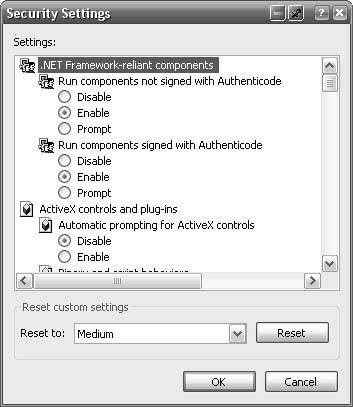 Next, go down the list and set each of the options as shown in Table 4-1. Depending on which edition of Windows XP you have and whether or not the latest service pack is installed, some of these options may be different or missing.
Click OK when you're done changing the security settings. Next, click the "Trusted sites" icon, click the Sites button, and remove the checkmark next to the "Require server verification (https:) for all sites in this zone" option. Then type the following URLs into the "Add this Web site to the zone" field, clicking the Add button after each one: http://*.update.microsoft.com https://*.update.microsoft.com http://*.windowsupdate.com http://*.windowsupdate.microsoft.com These four URLs permit the Windows Update feature to continue working unencumbered by your new security settings. The asterisks are wildcards, allowing these rules to apply to variants (such as http://download.windowsupdate.com). Feel free to add the domains for other web sites you trust, and then click OK when you're done. Now that you see what's required to make Internet Explorer safer (albeit not bulletproof), you might be tempted to dump IE entirely in favor of a better design. If so, you're in for a treat! Mozilla Firefox, available for free from http://www.mozilla.org, is an open source, standards-compliant web browser that is faster, much safer, and more feature-rich than Internet Explorer. It does a better job of blocking pop-ups, has a more customizable interface, and can be enhanced with powerful extensions (see "Improve Any Web Site" for an example). We'll look at Firefox and another Mozilla offering, Mozilla Suite, in several of the annoyances in this chapter. 4.1.2. Turn Off Internet ExplorerTHE ANNOYANCE: I've stopped using Internet Explorer completely, but the fact that it's still on my PC makes me nervous. Is there any way to uninstall it? THE FIX: Yes and no. Since Microsoft has so much at stake with Internet Explorer, the designers of Windows have gone to great lengths to make IE appear indistinguishable and inseparable from the rest of the operating system. However, several court cases (which Microsoft lost) have forced the company to include a way to hide Internet Explorer, effectively making it appear as though it has been uninstalled without hobbling IE-dependant features such as the help system and Windows Update. If you're using Windows XP with Service Pack 1 or later, open the Add or Remove Programs control panel, and click the "Set Program Access and Defaults" button on the left. In the "Set Program Access and Defaults" window (see Figure 4-2), you can choose a default web browser, email program, media player, and other Internet-related applications, as well as preventing unwanted programs from being used. Figure 4-2. Use the "Set Program Access and Defaults" window to completely block access to Internet Explorer. Choose the Custom option, and then click the double arrow to the right. In the "Choose a default Web browser" section, make sure your favorite web browser is selected, and then clear the "Enable access to this program" checkbox next to Internet Explorer. Click OK when you're done. 4.1.3. Choose a Default BrowserTHE ANNOYANCE: I've dropped Internet Explorer and switched to Firefox, but IE windows still appear when I click links in email messages. How do I make those links open in Firefox automatically? THE FIX: Make Firefox (or whatever browser is your favorite) the default browser, associating it with the .htm and .html file types and the HTTP and HTTPS protocols (among others). When you install any web browser, including Firefox and even new versions of Internet Explorer, you should be given the opportunity to make the newly installed program the default. But if, for example, you didn't make Firefox the default at that time, or another program made itself the default without asking, you must change the appropriate settings.
The easiest and least-destructive method is to use the browser's own self-default settings. For example:
If these steps don't work, reinstall the browser or use the "Set Program Access and Defaults" option in the Add or Remove Programs control panel, as described in "Turn Off Internet Explorer." 4.1.4. Fix Internet ShortcutsTHE ANNOYANCE: My newly installed browser works great, but after I installed it, the Internet Shortcuts on my desktop stopped working. THE FIX: An Internet Shortcut is a small text file (.url) containing the address of a web site and some other information. (You can create an Internet Shortcut by, for example, dragging the little icon to the left of the URL in the browser's address field to the Windows desktop.) Internet Shortcut files aren't associated with any particular browser, but rather with Windows's internal protocol handler (see the "How Internet Shortcuts Work" sidebar for details). To fix the problem, open the Control Panel, go to Folder Options, and choose the File Types tab. Select URL/Internet Shortcut from the list (ignore "(NONE)/Internet Shortcut" if you see it), and click the Advanced button. (If it's not there, click New, type url, and then click OK.) Double-click the Open item in the Actions list (or, if Open is not there, click New and then type Open in the Action field), and type the following command into the "Application used to perform action" field: rundll32.exe shdocvw.dll,OpenURL %l Next, check the Use DDE box. Leave the DDE Message field blank, type shdocvw in the Application field, leave the DDE Application Not Running field blank, and type System in the Topic field, as shown in Figure 4-3. Click OK in all three dialog boxes to confirm your choices. Figure 4-3. If Internet Shortcuts stop working, associate them with the shdocvw library.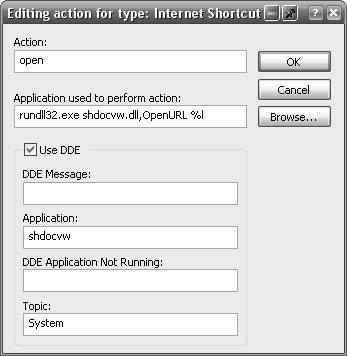 If Internet Shortcuts still don't work after this change, or if they open in the wrong browser, see "Choose a Default Browser." 4.1.5. Change Internet Shortcut IconsTHE ANNOYANCE: I chose Firefox as my default browser, but Internet Shortcut icons on my desktop still have the Internet Explorer logo. I'm so mad at IE for facilitating a spyware infestation on my system that I don't ever want to see that big blue "e" again! THE FIX: Not surprisingly, Microsoft likes its IE logo, and they don't want you to change it. Good thing we don't care what Microsoft likes. You've undoubtedly discovered that changing the icon through the File Types window doesn't workyou'll have to get your hands a little dirty to customize this icon. Open the Registry Editor (go to Start 4.1.6. Remember Web Site PasswordsTHE ANNOYANCE: I hate having to type my username and password into my favorite web sites every time I visit them. Internet Explorer sometimes prompts me to save my password, but I still have to type my username. This is idiotic; why can't IE just log me in automatically? THE FIX: IE's password-saving feature is not very well thought-out. By default, IE won't enter anything into login forms automatically, but will only fill in your password for you once you type in your username. Although you can turn this feature on or off by going to Tools The Mozilla Firefox and Mozilla Suite browsers, both freely available from http://www.mozilla.org, do a much better job of remembering passwords than IE. Whenever you type a password into a web form, the Mozilla browsers ask you whether or not you'd like to save the password. (You can also choose "Never for this site" to turn off the prompt for a certain site without disabling the feature altogether.) Thereafter, the Mozilla browsers will automatically fill in your username and password each time you visit a saved site's login page (Figure 4-4)no typing necessary! You can even view and edit your saved passwords: in Firefox, go to Tools Figure 4-4. Firefox does a much better job than IE of automatically entering usernames and passwords into web forms.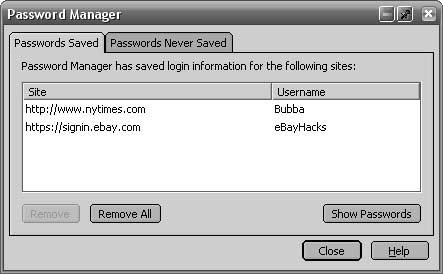 Although Firefox and Mozilla Suite will do the typing for you, they won't press Enter or click the login button for you. For that, you'll need RoboForm (free, http://www.roboform.com). It works with IE out of the box, or with Mozilla Firefox and Mozilla Suite via a variety of special extensions. Among its many talents, RoboForm can not only remember and enter usernames and passwords automatically, but can click Login buttons for you as well. Like the Mozilla browsers, RoboForm can also automatically fill in long web forms, but it goes a step further by supporting complex JavaScript-based forms. If RoboForm seems like overkill, try the free Google Toolbar, available for both Firefox and Internet Explorer from http://toolbar.google.com. It fills out forms for youalbeit without some of RoboForm's bells and whistlesbut it also adds a language translator, a text field spell-checker, and, of course, quick links to Google's web search engine. 4.1.7. Living with Firefox in an IE WorldTHE ANNOYANCE: Some web sites (including Windows Update!) won't let me in because I'm using Firefox instead of Internet Explorer. But I loathe IE; I'd rather not open up my PC to spyware just to download my phone bill. What are my options? THE FIX: Every browser has a user agent stringa text "signature" it sends to every web site you visit that identifies the browser name and version, and even the operating system version you're using. For example, Internet Explorer 6.0's user agent string looks like this: Mozilla/4.0 (compatible; MSIE 6.0; Windows NT 5.1) Firefox 1.5's looks like this: Mozilla/5.0 (Windows; U; Windows NT 5.1; en-US; rv:1.7.10) Gecko/20050716 (No IDN) Firefox/1.5 If you use Firefoxor any non-IE browser, for that matteryou'll occasionally encounter a web site that won't let you in. The problem is usually caused either by lazy developers who haven't made their web sites standards-compliant, or by corporate licensing restrictions that forbid developers from supporting any non-Microsoft products. The good news is that you can fool 'em all! The User Agent Switcher Extension for Mozilla Suite and Firefox (available for free from http://chrispederick.com/work/useragentswitcher/) allows both browsers to masquerade as any other browser, including Internet Explorer, Netscape 4, and even Opera. When you stumble upon an IE-only web site, just go to Tools Figure 4-5. Use the User Agent Switcher to masquerade Firefox as IE to gain entry to sites that don't expressly support Firefox.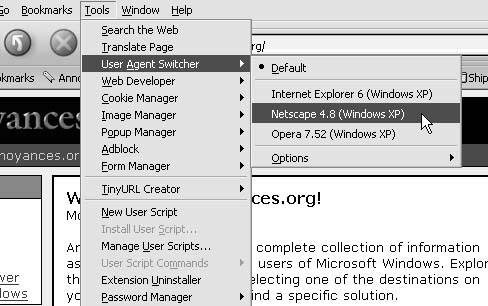 Note: When you find a site that doesn't work in Firefox or Mozilla Suite, send the webmaster a note and request that the site be made standards-compliant. A single email probably won't change the site owners' mind, but enough complaints may convince the webmaster to rethink the decision to support only Internet Explorer. Of course, dressing up your browser as Internet Explorer doesn't necessarily mean the site will work like it's supposed to. Often, these sites require Internet Explorer because they employ proprietary IE features, such as ActiveX add-ons that can open the door to spyware (see "Lock Down Internet Explorer"). In these cases, you must either view the page in IE or abandon the site. If you take the former course, you'll appreciate the IE View extension for Firefox and Mozilla Suite (freely available from http://ieview.mozdev.org). When you encounter a site that won't work properly in Firefox, just right-click an empty area of the page and select "View This Page in IE," or right-click any link on the page and select "Open Link Target in IE." 4.1.8. Funny Symbols in Web PagesTHE ANNOYANCE: I see funny symbols in the text on some web pages, particularly where I'd expect to see hyphens or apostrophes. What's wrong? THE FIX: You're viewing the site with the wrong code page. The code page is the assortment of characters your browser uses to render text, and it must match the code page that was used to create the site. Usually your browser picks the correct one automatically, but if you've previously changed the code page (or if another web site switched code pages on you), or if the web site doesn't specify the correct code page, the site won't display properly, as shown in Figure 4-6. Figure 4-6. If a web site looks like this, you have the wrong code page selected.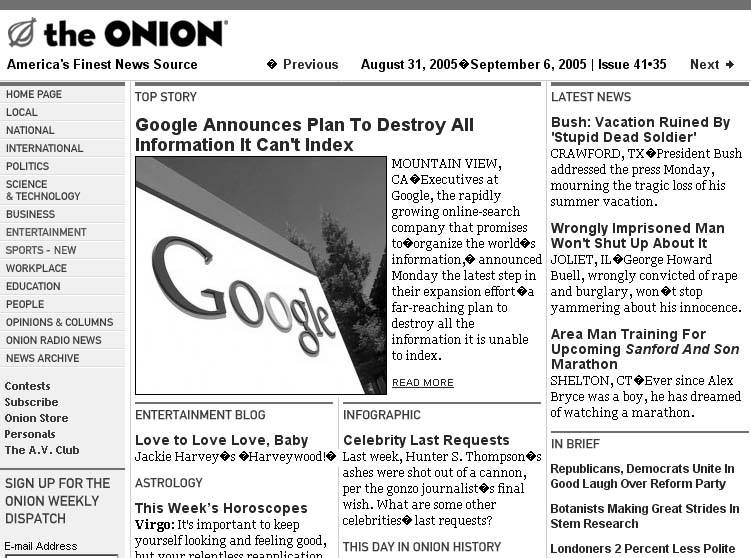 In Internet Explorer, go to View In Firefox and Mozilla Suite, go to View 4.1.9. Pictures Don't Show Up in Some Web PagesTHE ANNOYANCE: Recently, some icons, pictures, and photos appear to be missing from all sorts of web pages. Sure, these sites are loading faster, but porn sites aren't as much fun as they used to be. THE FIX: There are a bunch of things that can cause this problem. First, clear your browser cache to remove any corrupt data that your browser might be using to display pages. In Internet Explorer, go to Tools If you're using Firefox, go to Tools Some improperly configured firewall softwareparticularly Norton Internet Security and Norton Personal Firewallcan interfere with images in some web sites. Temporarily disable your firewall; if that helps, consult the firewall's documentation (specifically relating to the anti-hotlinking features) to fix the problem. (Note that neither the Windows Firewall nor most firewall-enabled routers typically exhibit this problem.) Ad-blockers may also be suppressing content you want to see. By design, ad-blockers block images, animations, inline frames, and other content served up by certain sites, but your ad-blocker might be blocking more than just ads. Many sites also pull non-ad content from these same servers, sometimes for economic or technical reasons, but primarily in an attempt to thwart ad-blockers. Either way, turn off your ad-blocking software to see if that solves the problem. Finally, bad proxy settings can break all sorts of things in web sites. If you're surfing from work, your employer may require you to go through a proxy server; turn it off and see if the problem stops. Likewise, if you're surfing from home and you're using a proxy server, you may have to turn it off to view sites reliably. In Internet Explorer, go to Tools 4.1.10. Improve Any Web SiteTHE ANNOYANCE: I love Google's Gmail service, but because there's no Delete button it takes three clicks to delete unwanted messages. While I'm at it, there are some things I'd like to change about other web sites, too. THE FIX: Use Greasemonkey to customize your favorite web sites. Greasemonkey is a free extension (available at http://greasemonkey.mozdev.org) for the Firefox and Mozilla Suite browsers that lets you add custom JavaScript code to any web page. The code then runs automatically as though it's part of the page itself and alters the page's appearance or changes its behavior. By itself, Greasemonkey doesn't do much. To bring Greasemonkey to life, you must install user scripts that you download or write yourself. Most user scripts are designed to add features to individual web sites, but some were written to fix bugs. Visit http://www.userscripts.org, and you'll find plenty of gems. For instance, there's a user script that adds your requested Delete button to Gmail (see Figure 4-7); another script changes Google's image search results so thumbnails are linked to their full-size versions. Figure 4-7. Use Greasemonkey to add features to web pages, such as this Delete button for Google's Gmail.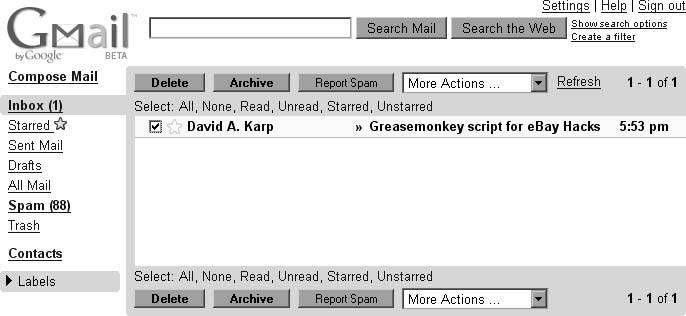 There are scripts for all sorts of web sites. In the eBay section, for instance, you'll find the "Show Only Negative Feedback" user script, which allows you to show only the complaints an eBay member has received (Figure 4-8)something eBay won't let you do. Figure 4-8. Greasemonkey is also responsible for adding the Complaints Left and Complaints Received tabs to this eBay page.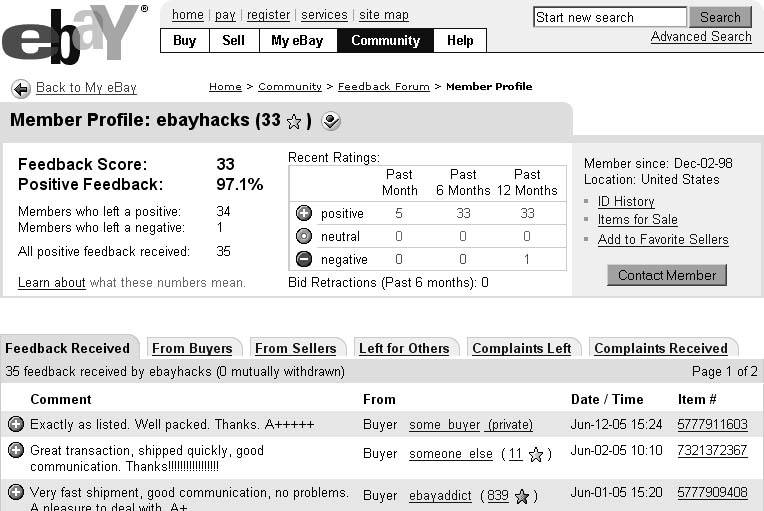 When you've found a user script you want, right-click the link to the script and select Install User Script. You can also click the link to display and examine the script in your browser, and then, if you like what you see, go to Tools Not all scripts are site-specific. The Linkifier script turns anything that looks like a URLon any pageinto an active link you can click. Similar scripts do the same thing for email addresses and even UPS and FedEx tracking numbers. The best part, though, is that with some knowledge of JavaScript, you can write your own user scripts and customize the Web to your heart's content! To get started authoring user scripts, visit http://greasemonkey.mozdev.org/authoring.html and pick up a copy of O'Reilly's Greasemonkey Hacks by Mark Pilgrim. Note: Greasemonkey works only with Mozilla browsers (e.g., Firefox, Mozilla Suite, Netscape). If you're using Internet Explorer, try Trixie (http://www.bhelpuri.net/Trixie/), which runs Greasemonkey user scripts on IE. Given that nearly all Greasemonkey user scripts are written forand tested withGreasemonkey, there's no guarantee that they'll work as well (or at all) with Trixie and IE. But if you're stuck with IE, Trixie is your best bet. 4.1.11. Put an End to Pop-UpsTHE ANNOYANCE: There should be a law against pop-up advertisements. I hate having to close all those windows when I'm trying to get my work done. THE FIX: Alas, I suspect anti-pop-up laws would be about as effective as anti-spam laws. But that doesn't mean you can't take matters into your own hands and stop the madness (more or less). In the old days, all you had to do was install a third party pop-up blocker, and you were set. Today, all major browsers come with built-in pop-up blockers (though some are better than others). The problem is that pop-ups are no longer limited to web sites, which means your anti-pop-up arsenal must grow to keep up. To block web-based pop-ups in Internet Explorer, go to Tools Figure 4-9. Mozilla Suite's pop-up blocker is particularly effective and makes it easy to allow pop-ups from certain sites Both Firefox and Mozilla Suite block more types of pop-ups than Internet Explorer, but only Mozilla Suite makes it easier to add exclusions. In Mozilla Suite, go to Tools Firefox is the only major browser to block pop-ups by default. To permit pop-ups from certain sites, go to Tools What if you have your browser configured to block pop-ups, but they're still occasionally showing up? If you see pop-ups when you're not surfing the Web, your PC may be infected with spyware, software designed to display advertisements and sometimes even monitor your surfing habits. Spyware, adware, and other types of malware (malicious software) come from some web sites, as discussed in "Lock Down Internet Explorer," and also piggyback on some downloadable applications (commonly P2P file-sharing programs and, strangely, many weather forecasting desktop applications). Note: Firefox and Mozilla Suite also give you more control over JavaScript, the programming language used to facilitate most pop-ups and add some other annoying traits to web sites. To tweak the JavaScript settings in Firefox, go to Tools  Options, choose the Web Features category, and click the Advanced button next to Enable JavaScript. In Mozilla Suite, go to Edit Options, choose the Web Features category, and click the Advanced button next to Enable JavaScript. In Mozilla Suite, go to Edit  Preferences Preferences  Advanced Advanced  Scripts & Plugins. In either browser, you can prevent sites from moving or resizing windows, changing the text in the status bar, and more by simply turning off the respective options. See "Improve Any Web Site for other ways to make sites less annoying. Scripts & Plugins. In either browser, you can prevent sites from moving or resizing windows, changing the text in the status bar, and more by simply turning off the respective options. See "Improve Any Web Site for other ways to make sites less annoying.Malware can be difficult to remove manually; the Add or Remove Programs control panel window is typically useless here. To get rid of these kinds of pop-ups, you'll need to install antispyware software. Among the best free antispyware tools are Spybot - Search & Destroy (http://www.safer-networking.org) and Ad-Aware (http://www.lavasoft.com). Also recommended is SpySweeper (http://www.webroot.com), which offers a free 30-day trial, and Microsoft's own AntiSpyware tool (http://www.microsoft.com/downloads/), which is free and worth a look. Note: Keep in mind that no antispyware program offers complete protection, so you may want to routinely scan your system with several of the antispyware tools listed here, as well as antivirus software, to keep your PC malware-free. Whatever package(s) you use, frequently run the tool's updater to make sure it's current on the latest threats. 4.1.12. Stop That Browser Hijacker!THE ANNOYANCE: I clicked a link on a web page, and I was suddenly transported to a search page I didn't recognize. The same thing happens on a bunch of different sites. Are these web sites broken, or is something else wrong? THE FIX: Your PC is infected with a browser hijacker, a form of malware that redirects the links in web sites to special advertising sites that generate revenue for the person who wrote the hijacking program. To get rid of the hijacker, use one or more of the up-to-date antispyware tools recommended in "Put an End to Pop-ups." If you don't have an antispyware program on your system, getting one after an infection can be difficult. Hijackers have a nasty sense of self-preservation and tend to block access to web sites offering antispyware tools. One way to get around a browser hijacker is to open the Windows Control Panel. If you don't see the task pane on the left (see Figure 4-10), go to Tools Note: If you know the exact URL of the .exe file to download, such as http://aspect1.tucows.com/files/spybotsd.14.exe, you can often get past a hijacker by typing the URL in your browser's address bar. With no links for the hijacker to redirect, the download should start right away. Figure 4-10. Use the Windows Update link in the Control Panel to open a safe Internet Explorer window.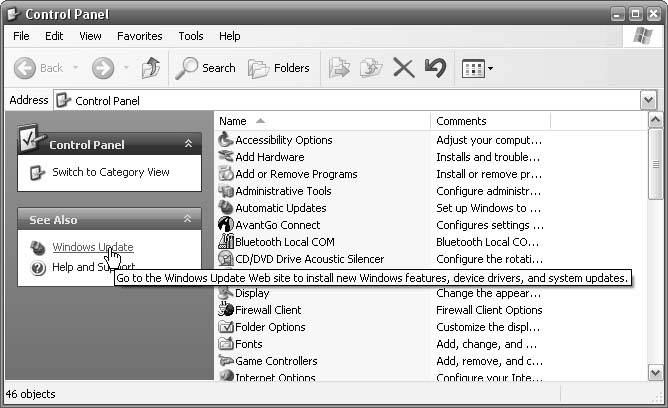 Note: Browsers based on the Mozilla engine, such as Firefox and Mozilla Suite, are better at saving form information, except under certain circumstances. For instance, if a form is generated on the fly, Mozilla browsers usually can't save the text you've typed into it. 4.1.13. Solve the Blank Form MysteryTHE ANNOYANCE: I filled out a form on a web page and clicked Submit, only to be told that there was something wrong with what I'd entered. When I clicked Back to return to the previous page, everything I typed was gone! What's wrong with the site? THE FIX: This is caused by a bug in your web browser, and not the web site. All versions of Internet Explorer, and older releases of Netscape (Versions 4.x and earlier), are affected by this bug. To date, no browser handles form data in previously visited pages perfectly, but there are a few workarounds. For one, most web site designers are aware of the bug and have built their web sites accordingly. So, if you submit a form and then need to go back and change what you've typed, don't press your browser's Back button; rather, look for a Back button or Edit button right on the page, and click it to safely modify your text. Next, make a habit of performing an impromptu backup before you submit any form. For instance, if you've written a long message, click in the text box, press Ctrl-A to highlight all the text, press Ctrl-C to copy it, open a text editor such as Notepad, and press Ctrl-V to paste it. (Repeat these steps for any long field in the form.) If you're later forced to return to the page by pressing your browser's Back button and the form is emptied as a result, you can simply paste your text back into the form. Finally, Mozilla Suite can pre-fill most types of web forms. Just before submitting a form, select Edit Note: RoboForm, which is discussed in "Remember Web Site Passwords," can also save form data, and it works with Internet Explorer and Firefox as well as Mozilla Suite. 4.1.14. Stop Annoying AnimationsTHE ANNOYANCE: The dancing hamster was cute at first, but now it's getting on my nerves. Everywhere I go on the Web, something is pulsating, flying across the screen, or playing music. How can I make this online circus stop? THE FIX: Pressing the Esc key stops most animations, but this is a temporary fix and works only with animated .gif image files. If you want to permanently disable .gif animations altogether in Internet Explorer, go to Tools Figure 4-11. Use the Advanced tab in IE's Internet Options to selectively disable animations, videos, and sounds in web pages. In Firefox and Mozilla Suite, type about:config into the address bar to show the staggering list of all available fine-tuning options for these browsers. Find image.animation_mode in the list (type something like anim in the Filter field to locate it quickly), double-click the option, and type none in the Enter String Value box. If you don't want to completely disable animations, you can type once here instead (normal is the default) to let sites play all animations only once, but never repeat (loop) them. Click OK when you're done. Other types of animations require different strategies. If the animation, video, or sound is coming from a Java applet, the only way to stop it is to turn off Java support altogether. In Internet Explorer, go to Tools JavaScript, not to be confused with Java, is often used to create flyovers (where a button or icon changes when you move the mouse over it) as well as cursor trails (the flying bits that follow your mouse pointer). To disable JavaScript in Internet Explorer, go to Tools Figure 4-12. Use the Adblock Mozilla extension to hide annoying Flash animations. Of course, none of this will disable plug-ins, such as Flash. To turn off Flash animations in Internet Explorer, you must uninstall the Flash player using Macromedia's elusive uninstaller tool, available at http://www.macromedia.com/support/flashplayer/ (search the knowledge base for "uninstall"). But in Mozilla Firefox and Mozilla Suite, you can use the powerful Adblock extension, available for free at http://adblock.mozdev.org, to selectively hide animations. Once it's installed, restart your browser, and then go to Tools Adblock supports wildcards, so, for instance, you can block all Flash animations from a particular server, rather than having to do it manually for each one. The next time you click an Adblock tab, you'll see the address of the .swf file, like this: http://advertising.server/ads/chipmunk.swf Just replace the filename with an asterisk (*), like this: http://advertising.server/ads/* to block all the files from the /ads/ folder on that server. Adblock will continue to hide these animations until you manually remove the corresponding rule from the Adblock Preferences window. Note: Of course, Adblock can block all animations with the rule, *.swf. But since some sites use Flash exclusively, don't be surprised if you occasionally encounter completely blank pages. 4.1.15. Open PDFs Outside the Web BrowserTHE ANNOYANCE: If I double-click a PDF file on my desktop, it opens in Adobe Acrobat. But if I click a link to a PDF file on a web page, the PDF opens in my browser window instead of Acrobat. How do I get PDFs to open in Acrobat all the time? THE FIX: When you view a PDF in a browser window, you're using an Acrobat plug-in that's installed automatically when you install Acrobat Reader (or the full version of Adobe Acrobat, for that matter). There's an option in Acrobat's Preferences dialog (go to Edit To bypass the plug-in, right-click links to PDF files and select Save Target As (Save Link As in Firefox or Save Link Target As in Mozilla Suite) to save them to your hard disk instead of opening them in the browser. (In Mozilla Suite, you can also hold Shift while clicking links to save their targets.) To disable the Acrobat plug-in altogether, exit your browser, open a Search window (Start 4.1.16. Control Tabbed BrowsingTHE ANNOYANCE: I upgraded to Firefox some time ago, and while I like it, I can't say I've ever warmed up to the idea of "tabbed browsing." Every so often I open a link in a tab instead of a new window by accident, and I can't seem to close it fast enough. It's infuriating that I can't turn them off completely. THE FIX: Some people like tabs because they reduce screen clutter, but if you like to view pages side by side, for example, tabs are just a nuisance. In Firefox, Ctrl-clicking a link opens it in a new tab, but Shift-clicking opens it in a separate window. (In Mozilla Suite, however, Ctrl-click opens new windows and Shift-click saves links.) To disable all tabs in Firefox permanently, install the free Tab Killer extension (available at http://extensionroom.mozdev.org/more-info/tabkiller), and restart Firefox. Firefox will now ignore any attempts to open new tabs, instead opening links in the current window. To have Firefox open such links in new windows, go to Tools Conversely, Firefox users who despise the pileup of windows and will happily put up with tabs to keep the browser window tidy can install the free Single Window extension (https://addons.mozilla.org/extensions/moreinfo.php?id=50) or the free This Window extension (http://extensionroom.mozdev.org/more-info/thiswindow). While you're at it, peruse both of these sites for dozens of other extensions that expand or tame this controversial feature. For instance, if you don't want to pick sides at all, you can install the free "Open link in…" extension (https://addons.mozilla.org/extensions/moreinfo.php?id=379). With this extension in place, right-clicking any link will display five different options: "Open Link in New Window," "Open Link in New Tab," "Open Link in New Background Tab," "Open Link in New Background Window," and "Open Link Here." 4.1.17. Faster Downloads Without the HassleTHE ANNOYANCE: Downloading files from the Web takes forever, and sometimes the progress bar just stops! How can I kick-start downloads? THE FIX: You need a download manager (sometimes called a download accelerator), a program designed to eliminate many of the inefficiencies in the download process. Unfortunately, most download managers are so cumber-some and poorly designed that you'll eat up a lot of time just setting them up before you begin each download. One of the only decent download managers is Download Express, available for free from http://www.metaproducts.com (see Figure 4-13). Figure 4-13. Use Download Express to accelerate downloads without filling in a page of options every time. Note: To integrate Download Express with Firefox and Mozilla Suite, install the MetaProducts Integration plug-in, which allows you to download any item with a right-click. Better yet, use the DownloadWith extension described in "Set Download Defaults in Mozilla Suite" to make Download Express your default down-loader for any or all file types. After installing Download Express, go to Start 4.1.18. Set Download Defaults in Mozilla SuiteTHE ANNOYANCE: When I download files with Mozilla Suite, I'm often asked if I want to open the file or save it to my hard disk. Even when I check the "Always perform this action" box, Mozilla Suite keeps asking me. How can I stop this endless badgering? THE FIX: This bug has been around for a long time in Mozilla browsers, although it was mostly fixed in Firefox. The solution is to install the free DownloadWith extension, available at http://downloadwith.mozdev.org, along with the Download Express download manager discussed in "Faster Downloads Without the Hassle." Install both programs, restart Mozilla Suite, go to Edit Note: If you only want to automatically download certain file types, select "Specific files" instead of "All files." Then type a filename extension in the "File type" field, minus the dot (for example, enter zip for .zip files). Choose MetaProducts Download Express, from the Application drop-down list, and then click the Add/Update button to add your new entry to the list. Click OK when you're done. From now on, to download a file from a web site, just click the link. Choose a folder to save the file in, and Download Express will handle the rest automatically. 4.1.19. Surf Anonymously for FreeTHE ANNOYANCE: I visited some web site that showed my IP address and even the state where I live. This is freaking me out. How can I mask my identity when I'm on the Internet? THE FIX: Use a proxy server to mask your IP address (and yes, your state) from the web sites you visit. As the name implies, a proxy server stands between your browser and the sites you surf, in effect "hiding" you from prying sites. Once you set up a proxy server, all information you send and receive with your browser goes through that server (email and other programs must be configured separately to use the proxy). Most large companies use their own proxy servers to help protect the data on company PCs from prying eyes, but you don't have to work at a big company to get the same protection. Start by visiting http://www.annoyances.org/ip/ to view your IP address as web sites see it. Then, go to http://www.proxy4free.com, click "Section 1.1" in the list on the left, and find any server marked "anonymous." Highlight its IP address and press Ctrl-C to copy it to the clipboard; also note the port number shown in the adjacent column. Next, configure your browser to use that proxy server. If you're using Internet Explorer, go to Tools The procedure is pretty much the same for other browsers. If you're using Firefox, go to Tools Now, go back to http://www.annoyances.org/ip/, and notice that your IP address has changed! (If you can't load the page, the proxy server is down; just choose another proxy server from Proxy 4 Free and try again.) From here on, until you disable the proxy, every site you visit will see your proxy server's IP address instead of yours. Figure 4-14. Configure a proxy server in your web browser to mask your IP address from prying web sites.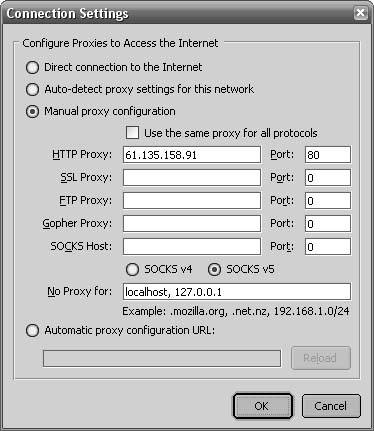
Every byte of data you send and receive with your web browser will be sent through the proxy server. Unless you knowand trustwhoever is hosting that server, you should always disable the proxy before sending sensitive information (e.g., your home address, credit card details, etc.). If setting up a proxy server sounds like overkill but you'd like to have protection on the odd occasions when you visit a site that you suspect may be harvesting information about you, an alternative is to use a free, single-serving proxy server, such as Proxify (http://www.proxify.com), The Cloak (http://www.the-cloak.com/login.html), or Anonymizer (http://www.anonymizer.com). Just type or paste the URL of the site you want to visit into the text box on any of these pages (at the Anonymizer site it's the Private Surfing box in the upper-right corner), and press Enter. The proxy site will load up the page, allowing you to surf anonymously for this session. Click links in the page to continue surfing anonymously, or use your browser's address bar, bookmarks, or Internet Shortcuts to return to normal, non-proxy surfing. Note: Anonymizer also has a free Privacy Toolbar (for Internet Explorer only, unfortunately), which does much the same thing as the web-based Anonymizer, albeit with a slicker interface. If you want more flexibility than web-based proxies can offer, try Anonymizer's $29.95-per-year Anonymous Surfing tool or the $9.95 Anonymous Browsing Toolbar 3.3 (http://www.amplusnet.com). These programs, which run on your PC, perform pretty much the same function as the web-based proxies discussed above, but with more features and speed. All things considered, these software-based proxies are probably marginally safer than anonymous proxies and less of a hassle than web-based proxies. Now, you might be thinking, why not just use a router? Well, routersdiscussed in Chapter 5offer terrific firewall production and indeed act as a layer between your PC and the rest of the Web. But when you surf from behind a router, web sites see your router's IP address, and thus can still collect all the same information about you and your geographical location. (See the "What Can They Find Out About You?" sidebar on the previous page for details.) |
EAN: 2147483647
Pages: 69